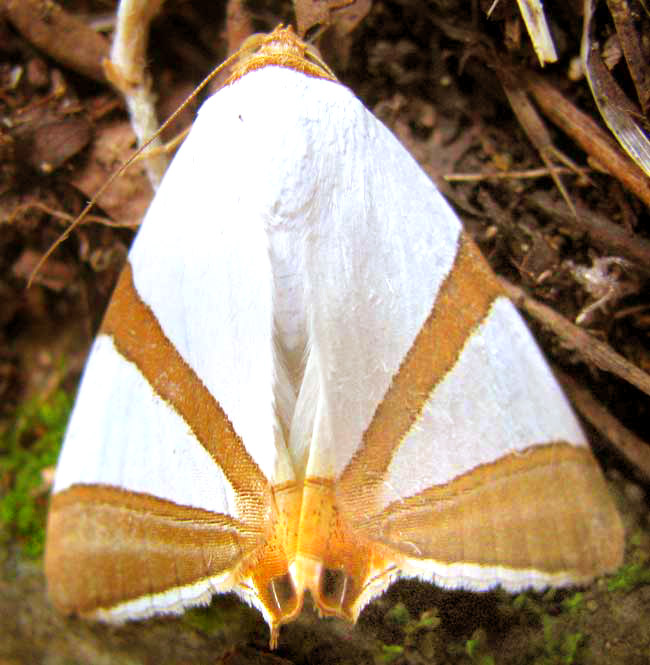Excerpts from Jim Conrad's
Naturalist Newsletter

from the January 24, 2010 Newsletter issued from Hacienda Chichen Resort beside Chichén Itzá Ruins, central Yucatán, MÉXICO; limestone bedrock, elevation ~39m (~128ft), ~N20.676°, ~W88.569°
A WRONG-HEADED MOTH
The other day right in the middle of the trail through shadowy forest I came upon the interesting moth shown above.
One point of interest there is how the moth's patterning gives the impression that the head is at the rear end. A predator might interpret the two dark spots as compound eyes, the two hairlike appendages below the bogus eyes as antennae, the golden area as the thorax, and the spread wings as radiate from the "golden thorax." A predator laboring under these misapprehensions and trying to incapacitate his prey by striking at the head might end up doing no more than leaving a gash in the moth's back wing area, and maybe a sore tail.
Even if the predator doesn't have brains enough to be deceived like that, the bold brown lines on a white background function as "disruptive patterning," which breaks up natural lines and cause the various parts of an organism to more or less blend with a background's random clutter. This trick wasn't working at all for the individual in the picture, though, for the white triangle on the dark forest floor couldn't have been more conspicuous. I don't know why the moth was there, and saw it do nothing more than what you see in the picture.
Bea in Ontario tried in vain for three days to identify the moth on the Internet but in the end she gave up and sent the picture to Paul Opler, who oversees the Butterflies and Moths of North America website at http://www.butterfliesandmoths.org.
Paul replied: EULEPIDOTIS RECTIMARGO
Though references to this species can be found from Texas and Costa Rica, and unnamed photos of it occur here and there on the Internet, there's hardly any other information generally available. Therefore, maybe this entry will help the next person who tries to learn something about this fabulous little being. We're adding to the public domain the fact Eulepidotis rectimargo is found here in January, and that sometimes it rests very quietly and conspicuously on shadowy forest floors.